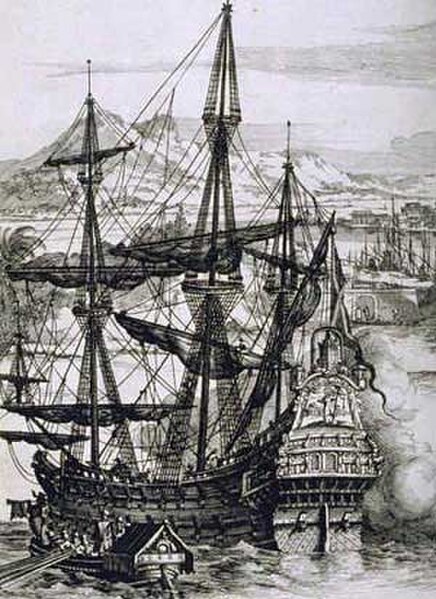The Manila galleon, originally known as La Nao de China, and Galeón de Acapulco, refers to the Spanish trading ships that linked the Spanish Crown's Viceroyalty of New Spain, based in Mexico City, with its Asian territories, collectively known as the Spanish East Indies, across the Pacific Ocean. The ships made one or two round-trip voyages per year between the ports of Acapulco and Manila from the late 16th to early 19th century. The name of the galleon changed to reflect from which city the ship sailed, setting sail from Cavite, in Manila Bay, at the end of June or first week of July, starting the return journey (tornaviaje) from Acapulco in March–April of the next calendar year, and returning to Manila in June–July.
Manila galleon (c. 1590 Boxer Codex)
Northerly trade route as used by eastbound Manila galleons
Sample of goods brought via Manila galleon in Acapulco
Spanish galleon
New Spain, officially the Viceroyalty of New Spain, originally the Kingdom of New Spain, was an integral territorial entity of the Spanish Empire, established by Habsburg Spain. It was one of several domains established during the Spanish conquest of the Americas, and had its capital in Mexico City. Its jurisdiction comprised a large area of the southern and western portions of North America, mainly what is now Mexico and the Southwestern United States, but also California, Florida and Louisiana; Central America, the Caribbean, and northern parts of South America; several Pacific archipelagos, most notably the Philippines and Guam. Additional Asian colonies included "Spanish Formosa", on the island now known as Taiwan.
Hernán Cortés and La Malinche meet the emperor Moctezuma II in Tenochtitlán, November 8, 1519.
The evangelization of Mexico
An auto-da-fé in New Spain, 18th century
Vázquez de Coronado Sets Out to the North (1540), by Frederic Remington, oil on canvas, 1905








